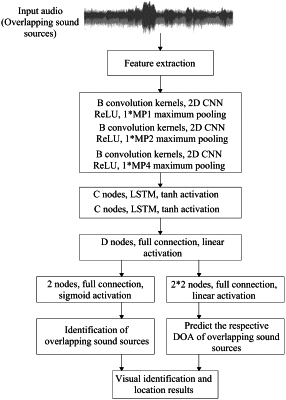| CPC G01M 99/005 (2013.01) [G06N 3/044 (2023.01); G06N 3/045 (2023.01); G06N 3/0464 (2023.01); G06N 3/08 (2013.01); H04R 1/406 (2013.01)] | 5 Claims |

|
1. A fault signal locating and identifying method of industrial equipment based on a microphone array, comprising the following steps:
1) Acquiring sound signals through the microphone array, and dividing the acquired sound signals into a training set, a verifying set and a test set;
2) Performing feature extraction using a feature extraction module on the sound signals in the training set, and performing a discrete Fourier transformation on the sound signals to extract a phase spectrogram and an amplitude spectrogram of a spectrogram;
3) Sending an output of the feature extraction module, as an input, to a convolutional neural network (CNN), and in each layer of the CNN, learning a translation invariance in the spectrogram by using a 2D CNN;
4) In between layers of the CNN, normalizing the output by using a batch normalization, and reducing a dimension by using a maximum pooling layer along a frequency axis;
5) Sending an output from the layers of the CNN to layers of a recurrent neural network (RNN) so as to learn time context information of audio signals;
6) inputting a full connection layer comprising D nodes, and using a linear activation function;
7) inputting an output of the full connection layer to two parallel full connection layer branches for fault identification and fault location, respectively; and
8) verifying performance indexes of a network model by the verifying set, and verifying generalization ability of the network model by the test set, by performing a DOA error calculation, determining a prediction accuracy of the network model, calculating a precision rate and a recall rate of classification indicators, and calculating a harmonic mean F1 of the precision rate and the recall rate,
wherein a convolutional recurrent neural network is built by connecting the CNN and the RNN in series, and the CNN is used to learn a spectral structure information of the sound signals, and the RNN is used to learn the time context information, thereby achieving fault location and identification.
|